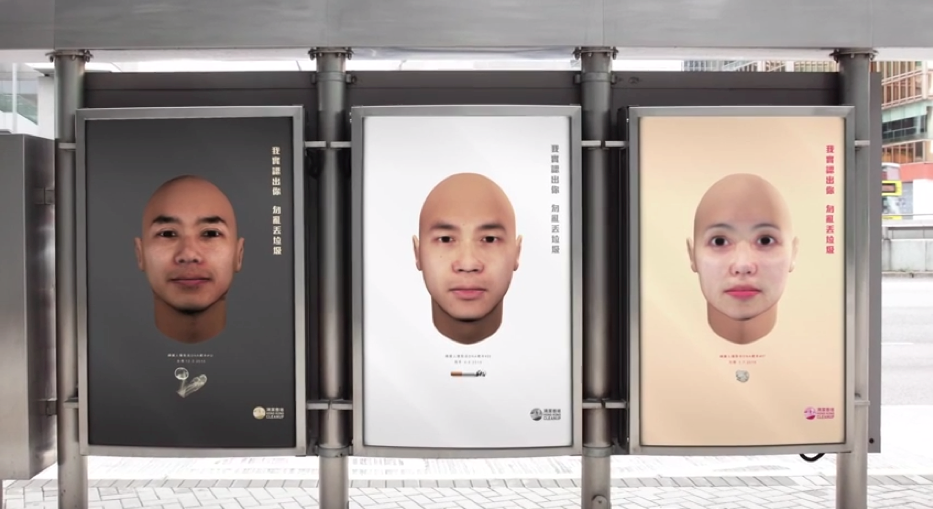The New Scarlet Letter: Hong Kong Uses DNA Tests to Publicly Shame Litterers

Just when you thought that it was safe to throw a cigarette into the street – Hong Kong Cleanup found a way to use sophisticated DNA techniques to show the world the faces of the people littering their city. “Phenotyping” is a new technology, enabling scientists to reconstruct the features of a person from a sample of saliva, hair, or other tissue. While obviously useful in the search for murderers, it’s cheaper every day to sequence DNA, and Heather Dewey-Hagborg’s recent high-tech art exhibit in which she made 3D-printed masks from trash was destined to attract attention from the people tasked with keeping urban spaces clean. The path from urgency to art is one that all great tools will take, and phenotyping’s no exception. Now, if you are careless with your garbage, you might see your own CG “police sketch” staring back at you from bus stops, simulated from the gum or condom you decided was somebody else’s job.
Here’s the thing about our ever-more-transparent world: when everything’s recorded, everyone’s accountable. The visages of litterers called out like Hester in The Scarlet Letter could easily be those of government officials. States might try to outlaw video recording of police, but even greater forces are at work to make it mandatory for a cop to wear a body camera. With WikiLeaks on one side and Korea’s Sony hacking on the other, Google tracking everything we do and NSA officials saving everything that anybody says for future reference, we’re already light-years past the traffic cameras at intersections and in schools that freaked us out mere years ago.
It isn’t just a one-way mirror, titans fighting one another while we scamper underfoot. Where once the LANDSAT photos of our Earth from space were closely guarded secrets, now we all have Google Earth. Where once transnationals could push whatever crap on people they desired, now we have a score of apps designed by teenagers that let us check to see who made the items we might buy, what politicians they support, and whether they’re committing any crimes against our ecosystem. The more empowered everyone becomes from access to the World Wide Web, the more that our collective knowledge-gathering enables individuals to act with what was once a power held exclusively by states – including spying on those states and acting on the knowledge of their former secrets. In this way, “co-veillance” – true policing in the early sense of it – unites the people and the city in emergent, self-supporting, omnipresent observation, balancing, and guidance.
Just as we’re all united in our nudity beneath the clothes, all of us are equals in an age when secrets can’t be kept. We’re not there yet, and we may never be, but we are closer than we were in generations past – more like the small town vibe in which we all are privy to each other’s “private” business than the anonymity of modern cities.
What happens to the self in futures such as this? The walls of our taboos are scheduled for demolition; nudist colonies don’t suffer from the fashion trends or body issues plaguing everybody else. Rule 34 – ”if it exists, there’s porn of it” – is one articulation of the way in which our seemingly one-of-a-kind identities reveal as shared realities online. Dan Savage’s assurance to gay teens that they are not alone, the “It Gets Better” movement, is another. When everybody’s youthful indiscretions are available to access decades later, nobody will have the grounds to punish other people for what they could just as easily be implicated in. (Every sinner has a future, every saint a past.)
And then, when we are stripped of our delusions that we’re truly, deeply different from everybody else, that we’re shamefully (or pridefully) unique and isolated in our selves (or joined as tribes against a Very Different Other), what happens to the selves we’ll probably continue to experience? Can we authentically maintain the sense of separation necessary to identify as modern individuals when we’re confronted with the striking similarity of every human’s inner life? When every last frontier of mind and body’s named and quantified, when we can’t hide from one another, who is left?
Michael Garfield is an evolutionary biologist and science writer, painter, guitarist, and the host of Future Fossils Podcast. Enjoy his extensive free archives at Patreon.

So wild!
Wow creepy.